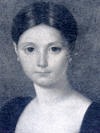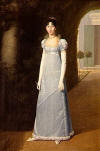The sisters Zénaïde and Charlotte Bonaparte, Napoleon's nieces, embrace as they read a letter from their father, Joseph Bonaparte, who was exiled in the United States while they lived in Brussels, Belgium, after Napoleon's fall from power. The folds of the carefully creased paper are realistically rendered, and the viewer can even decipher a Philadelphia address on the letter.
Jacques-Louis David juxtaposed the sisters' different personalities through their contrasting expressions and attire. The elder Zénaïde appears worldly and elegant in a low-cut black velvet dress. Sitting upright, she looks frankly out at the viewer as she protects her younger sister, Charlotte. Charlotte appears timid and reticent as she shyly raises her eyes, and her dress, a modest gray-blue silk, suits her demeanor. The exiled princesses both wear tiaras and sit on a red velvet couch embroidered with golden bees, the Bonaparte family emblem.
 Letizia
Letizia| Zenaïde and Charlotte Bonaparte in 1821, |
Charlotte Bonaparte (1802-1839), Princess and Artist
An exhibition co-organised by the Museo Napoleonico, Rome, and the Sovraintendenza ai Beni Culturali del Commune di Roma, the museo Nazionale delle Residenze Napoleoniche dell’Isola d’Elba and the Soprintendenza APPSAD per le Provincie Pisa e Livorno, the Rmn, the musée national des châteaux de Malmaison et Bois-Préau.
Charlotte Bonaparte (1802-1839), Napoleon Bonaparte’s niece and the younger of the two daughters of Joseph, King of Spain, had an unusual life, which is unjustly little known. Her interest in art led her not only to draw and paint but also to meet and make friends with the artists of her time. Her mother, Julie Clary, chose not to follow her husband to Naples and Spain, preferring to live with her daughters, Charlotte and Zenaide, in her mansion at Mortefontaine. They divided their time between their quiet home and grand festivities at the Imperial Court. After the fall of the Empire, when her father left for the United States of America, the political destiny of the Napoleonides forced her into a wandering life between Frankfurt and Brussels, the United States and England before she finally settled in Florence and Rome. Her strong, likeable personality opened doors to a cultivated cosmopolitan society in which she was much admired. In Brussels she studied under David. All her life she mixed with artists, particularly those working in the two Italian cities in the second quarter of the 19th century. This exhibition presents her sketchbooks of drawings and watercolours, now in the Museo Napoleonico in Rome. Alongside numerous works by Charlotte herself it includes drawings by artists she knew (Bartolomeo Pinelli, Léopold Robert, Michel Stapleaux, François Granet, Charles Müller, Charles Doussault, Edouard Odier, Nicolas-Didier Boguet, Samuele Jesi…) and even members of her family or enlightened amateurs who regularly attended her salon. These particularly significant works from the Romantic movement of 1820-1840, contextualised by personal mementoes and objets d’art belonging to the Bonapartefamily, give a glimpse of the various stages in the life of Princess Charlotte, and the tribulations brought not only by her exile but by the early death of her husband, her cousin, Napoleon-Louis. The exhibition opens with her childhood and teenage years. Drawings give a glimpse of her peaceful home life at Mortefontaine while official portraits by artists such as Gérard, Wicar or Lefèvre, made when Joseph acceded to the thrones of Naples (1806) and Spain (1808), recall the great imperial ceremonies in which she took part.
Next come the years of exile in Frankfurt (1816-1820) and Brussels (1820-1821), without Joseph, who was exiled to the United States in 1815. The stay in Brussels was decisive forCharlotte who attended David’s studio there and made several portraits of Zenaide, including the only oil painting that can be reliably attributed to her.
In 1821, she set off for the United States (1821-1824) to visit her father in his New Jersey property. The North American wilds inspired a series of remarkable landscapes. The trip also precipitated her marriage to her cousin, Napoleon-Louis (celebrated in Florence in 1826), the prelude to a period of quiet happiness. In 1824, she joined her mother in Florence and then settled with her husband, not far from Rome, where Zenaide lived. The works here refer successively to her salon in Florence, attended by many artists and intellectuals, the death of Prince Napoleon-Louis in 1831, her trip to London in 1833, when the entire Bonaparte family gathered after the death of the Duke of Reichstadt – a fertile journey in artistic terms – and her last years, in Rome, until her sudden death at Sarzana, near Lucca. This exhibition was first presented at the Museo Napoleonico in Rome, from 5 February to 30 May 2010, and then at the Musée Napoléon on the island of Elba from 15 June to 30 September 2010.
General curators : Maria Elisa Tittoni, dirigente dei Musei d’Arte Medievale e Moderna del Commune di Roma, Guilia Gorgone, dirrettrice del Museo Napoleonico di Roma
Curators : Amaury Lefébure, director of the musée national des châteaux de Malmaison et Bois-Préau, Elisabeth Caude, chief curator at the musée national des châteaux de Malmaison et Bois-Préau
Designed by : Frédéric Beauclair D.S.A.A.
Curators : Amaury Lefébure, director of the musée national des châteaux de Malmaison et Bois-Préau, Elisabeth Caude, chief curator at the musée national des châteaux de Malmaison et Bois-Préau
Designed by : Frédéric Beauclair D.S.A.A.





No comments:
Post a Comment